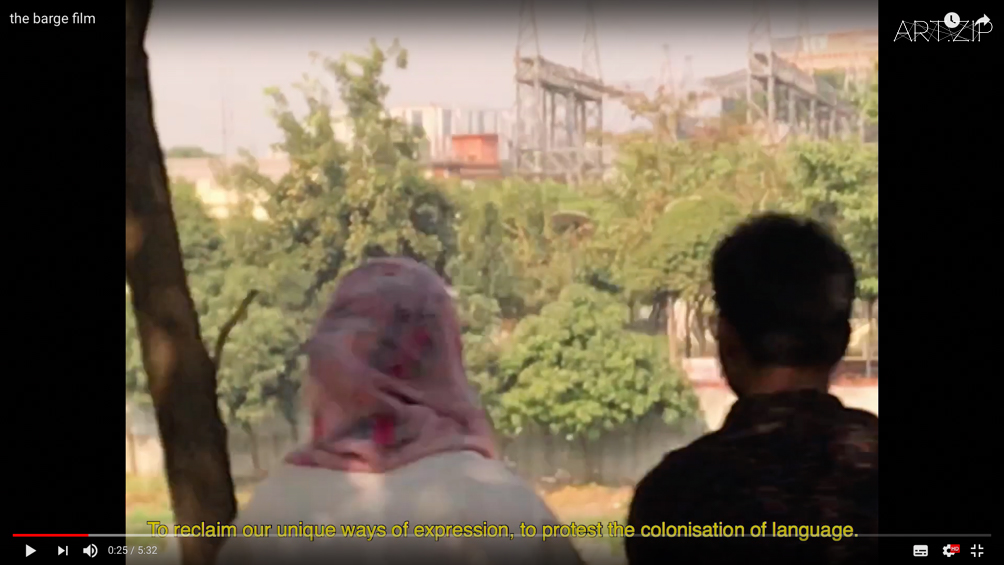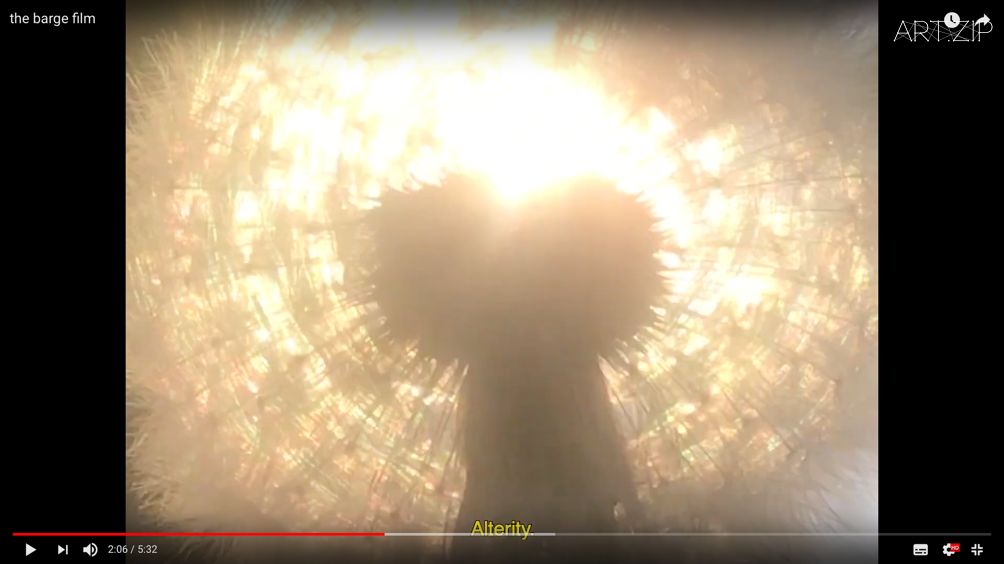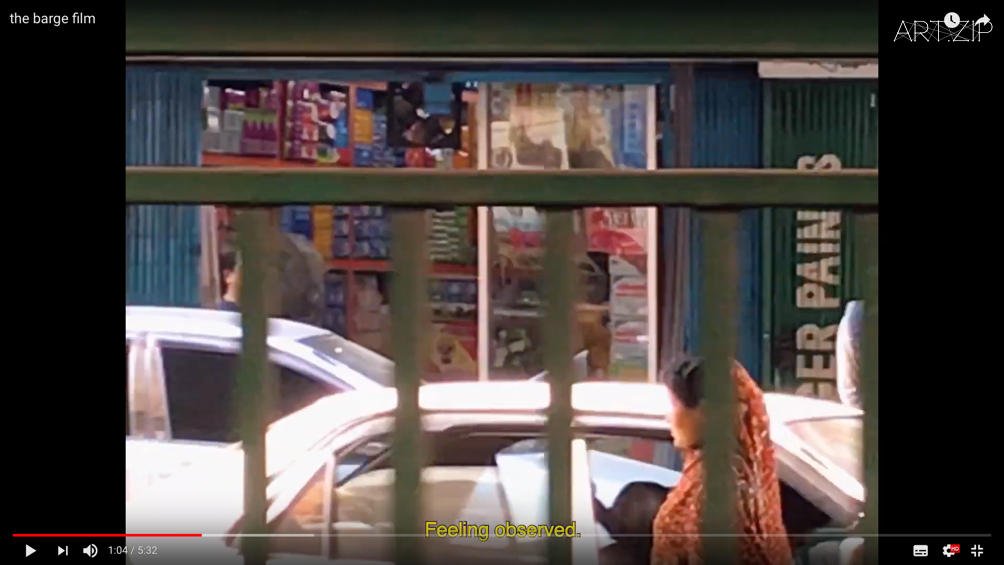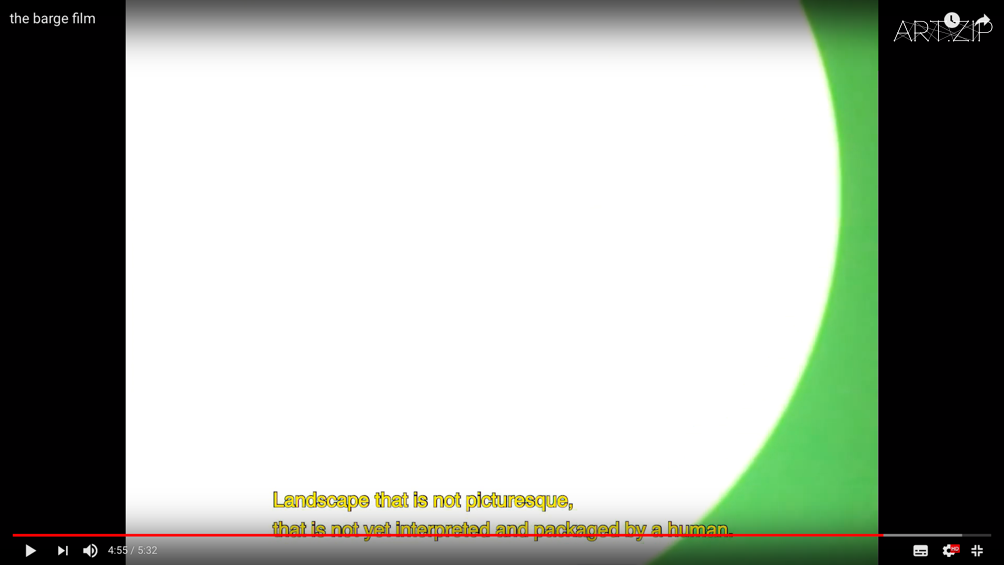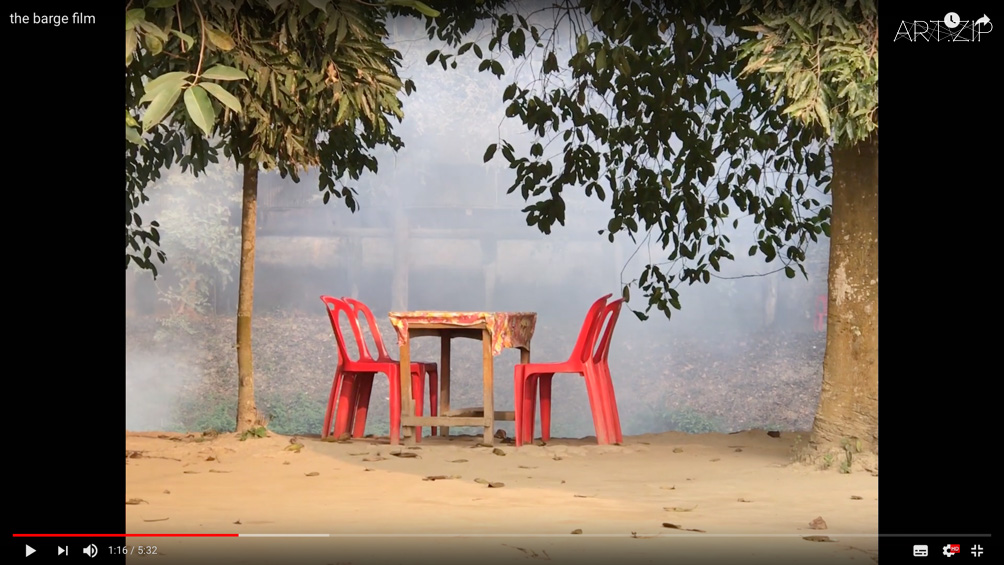
The Existential Paradox
A personal view on Violet March’s video art
Separation is itself part of the unity of the world, of the global social praxis split up into reality and image.
Thesis 7, La Societé du Spectacle
27th April, at the Barge, Marina Brighton, artist Violet March had her latest video art on display. It was a 5:32 min long documentary, footage of the artist’s life journey and her critical thinking on individual existence. The form of the footage is paradoxically concrete and abstract, and the viewpoint is arguably through her first-person gaze as well as through that of her alien I.
The opening pans rapidly in horizontal, signifying the anxiety caused by travelling through both time and space. Each individual is on their journey that is axiomatically mobilised, due to the laws of action. Stasis is one façade of motion, under the disguise of relativity. One is reluctant to admit mortality is evident, while nihilism is fate, according to Buddhism. The floating world gives the sense of our fragile existence as if we were trapped in a dizzy state of mind. The alien I, generates with the awareness of being an individual, for the necessity of self-consciousness.
In woman, on the contrary, there is from the beginning a conflict between her autonomous existence and her objective self, her “being the other”; she is taught that she must try to please, she must make herself object; she should therefore renounce her autonomy.[1]
Two pink chairs indicate past dialogues between two female individuals, and the absence of the human figures suggests the aftermath of the conversations. The scene was both symbolic and existential. The Voiceover shifted from legible English to Russian. Russian in this context serves a contradictory term: primal phenomenon and alienation. For people who are not familiar with the language can still sense the emotional remark, which is fatigue and seemingly futile.
Magnifying plants, the detail has rendered into abstraction. The artist expressed her pursuit of freedom by dreaming of floating. Off the grid, a sense of libertarian from shackles of social conventions, discriminations and burdens of languages. Languages, whether they are visual, textual, audial or physiological, in the coded contexts, gravitate towards some definitions.
At the beginning of the twentieth century, it was a lady, Hilma af Klint, who began considering a new form of art, to create something universal, yet not referring to the existing world: Abstract Art.
Ironically, the advancement of the abstract art has been claimed by the social norm – the artistic revolution in form, in media and spirit was carried out by the male members of the society. In the post-internet era, everything seems to fall apart, the totalitarian social structure, the conventional familial relationship, rational thinking are all rendered by the fragmented slices of life [tranche de vie]. It explores our understanding about the world and the self, as Albert Camus pointed out: “…with its first move this world cracks and tumbles: an infinite number of shimmering fragments is offered to the understanding. W must despair of ever reconstructing the familiar, calm surface which would give us peace of heart”.[2]
This modern condition is expressed democratically. By means of contemporary and affordable mobile phone cameras and editing apps, a much convenient way of documenting and exhibiting might be achieved, so that intelligence to some extent is able to free from the materially based budget. When resources are possessed and exploited, so are human beings. Viewing this world, whether, in the developed or the underdeveloped regions, the same mistakes and tragedies are repeated as if it is an endless charade. One is bound to act as an alien I to spy on it while one is also feeling observed because one scarcely had the choice of less dominated.
The argument in Russian, was a nightmare, a painful memory, a conversation between a mother and a daughter. Being an artist is a privilege, yet it sometimes brings worry, as it might not be a financially sensible choice, more importantly, avant-garde creativity requires critical and rational thinking, which is anything but conventional and stable. One generation after another, one wave after another, mothers and daughters have struggled in independence, confidence, and reconciliation with the self and the external world.
…the daughter is for the mother at once her double and another person, the mother is at once overweeningly affectionate and hostile toward her daughter; she saddles her child with her own destiny: a way of proudly laying claim to her own femininity and also a way of revenging herself for it.[3]
Allegedly, most people judge a book by its cover, as the human physical appearance has particular appeal to many people. Arguably, it has its validation; otherwise the entire designing industry will have no value. A good book is not just about the content, but also its influence, which involves series and serious publicity schemes, and a better cover, excellent texture of the paper, and appropriate fonts do matter. It would be wrong to draw an analogy between a human being and an object, especially in the case of feminism. Albeit, it is in human nature to compare and judge based on the visual. Objects are rendered into symbols and symbols refer to animated human beings. With the right context, appealing gaze, body, complexion could reflect the inner movement. Nevertheless, the point is if “beauty” is a quintessential trait and are males less discriminated by this than females, especially in relation to work, the source and power of being independent.[4] What is the currency of an artist?
Apart from the gender issue, the secondly struggle here is caused by the pursuit of being an artist. In the video, Violet fully expressed her understanding of the nature of human suffering, and there is no point of mystifying nor demystifying the privilege of being an artist. She explored the existential paradox with concrete and honest emotional catharsis. The suffering and hope are packed in the form of mobility.
Not every artist is like Vincent van Gogh or Amedeo Modigliani, whose personal struggle sometimes seemingly superseded their art in the artistic myth. Meanwhile, many artists enjoyed their patronage during their lifetime, but it does not mean their critical force was neutralised by the social conservative, on the contrary, they cultivated or worked their patrons and marked out a new world. From Michelangelo to Picasso, from Georgia O’Keeffe to Yayoi Kusama, from Francis Bacon to Andy Warhol, from Judy Chicago to Tracy Emin, they enjoyed their success, while still suffered, simply because artists are essentially human beings, and they are not super-human. Leni Riefenstahl was tempted by the idea, and the political connotation leads to disaster. That is to say, artists can transgress social rules but not transcend natural rulgulations. Even as marvellous as Leonardo da Vinci, one ought to know he struggled with Latin and sculpture.
The artist utilised a dandelion to symbolise her questioning about the rooting. Are roots countable? There is a linguistic pun. It is shrewd observation and summary. The form of the dandelion as a whole is visually pleasing, yet dandelion is a collective inflorescence, pseudanthium (composite flower) to be specific, once the individual is matured, flowers would float around in the wind, thusly become rootless. The bohemian condition of being an artist or human is very much against the nonsense that is generated from and for a sort of order, boundary and moral code, such as border, territory caste and et cetera. If there must be rules, then let it be looking for the light, like a sunflower to the sun, like a moth to the flame. As the artist pointed out “thought is not a primary access mode”, it should be the action.
Last but not least, there is a slight hint on post-colonial culture. In this case, the locale of Bangladesh is a starting point. Imperialist Colonialism caused a series of severe ethical issues; nevertheless, the original and fundamental form of colonisation is about energy flowing. Human beings move around the world to mobilise the resources, meanwhile conquering and slavery is the byproduct of the human lust. To have a space of one’s own is conflicted with the infinite desire for the external world, the resource of which does have its limitations. When the East Bloc collapsed, people in Europe had high hope as if the intensive crisis were solved and all can enjoy democracy and peace in New Europe. In actuality, the unequally progressed globalisation was masked by the joy of embracing the new millennium. The expansion of the EU and the unification of currency made people ignore the immigrant issues, and it only took no more than a decade to see the apparent.
The North-south Divide like racism or other kinds of social discrimination is primarily an issue of unequal dissemination of power. The special issue of Granta New Europe! has already foretold the struggle, people live in boarders suddenly were able to liberate from suppression yet had to face the fear of segregation and the sense of chaos.[5] Moreover, it is also part of the concrete truth about the artist life, even though she expressed it subtly via an abstract form.
In the end, she said free language, and it is a clear response to her existential paradox.
Epilogue:
Пять поколение женщин знающих травм ассимиляции.
Ассимилирует вся копирую притворяйся наряжаемся не привлекай внимание являйся красиво они громко.
Во сне спорила с мамой старалась доказать что что моя художественная работа имеет смысл что-то важное нужен до этого сна.
Я думаю что проблема увидеть саму себя оказывается всё это время я разговаривала с моей мамой.
[1] Simone de Beauvoir, 1993, The Second Sex, trans by H. M. Parshley, Everyman’s Library, p. 295.
[2] Albert Camus, 2005, The Myth of Sisyphus, Great Ideas Edition, Penguin Books, p. 17.
[3] Ibid., pp.295-296.
[4] Naomi Wolf, 1991, The Beauty Myth, Vintage Books, p. 20.
[5] New Europe!, 1990, Granta, Faber & Faber.
Text by Anna Talbot Rice

